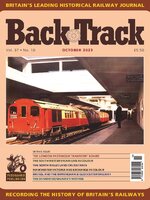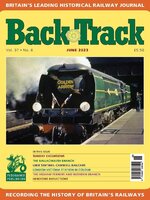Backtrack, Britain's Leading Historical Railway Journal, covers all aspects of railway history from its earliest days through to more recent events up to around ten years before now including, early railway history from the 'pre-Stephenson' era, steam, diesel and electric locomotive history, railway company history, railway carriages and wagons, railway stations, railway ships, hotels & road vehicles, railway economic and social history, railway publicity and advertising. Backtrack's contributors include many of today's leading railway history writers. From the beginning the magazine has maintained a reputation for its production values and each issue contains a wealth of photographs reproduced to the highest standards, including a generous selection of historic colour. Published monthly, Backtrack is THE magazine for all who are interested in British railway history.
Editorial • A grand day out
Backtrack
MORE FROM THE IN-BETWEENERS
HEREFORD REFLECTIONS • MICHAEL H. C. BAKER shares some memories of a favourite location.
SUNDAY EXCURSIONS • ALISTAIR F. NISBET looks back at the once extensive lengths to which railways – particulaly the Southern Region – went in order to provide people with a day out at the seaside.
KEEPING THE WAGONS ROLLING • Last year we featured two sets of photographs of non-passenger trains – parcels and goods – from the SIMON LATHLANE Collection. Here is a third selection.
THE HIGHAM FERRERS AND RUSHDEN BRANCH OF THE MIDLAND RAILWAY
‘ROCKET’ AND ITS KIN PART TWO ‘ROCKET'S SISTERS
AS IN VICTORIA'S GOLDEN DAYS
GOING GREEN AT GARGRAVE • These two examples of a British Railways ‘green revival’ were photographed at Gargrave by KEITH DUNGATE on 1st August 1986.
CHRONICLES OF JOHN BOYD'S SIDING • How a cross-border railway, later reduced to a half-mile siding, came to host a little engineering works with a big reputation.
THE DEMISE OF THE BALLACHULISH BRANCH • In the second part of his Scotland's Lost Branch Lines: where Beeching got it wrong,1 DAVID SPAVEN dissected a dozen individual line closures, exploring the rights and wrongs of Beeching's approach to loss- making secondary railways. Here, in an edited extract, he examines the sublimely scenic Ballachulish branch and reveals a little-known 1960s attempt to enhance the line's connectivity, rather than closing it.
STEAM AND DIESEL AT THE FORD MOTOR COMPANY
STAYING SINGLE
LNER SENTIEL-CAMMELL RAILCARS WEST OF THE PENNINES 1929-1944
WREXHAM TO PWLLHELI IN 1959
Readers’Forum • Letters intended for publication should ideally add extra detail to our articles (or offer corrections of course!) and not be too long, consistent with the detail they offer. As always, we are sorry that space and time prevent us from printing them all or sending personal replies. ED.

 Volume 39 No 1 - January 2025
Volume 39 No 1 - January 2025
 Volume 38 No 12 - December 2024
Volume 38 No 12 - December 2024
 Volume 38 No 11 - November 2024
Volume 38 No 11 - November 2024
 Volume 38 No 10 - October 2024
Volume 38 No 10 - October 2024
 Volume 38 No 9 - September 2024
Volume 38 No 9 - September 2024
 Volume 38 No 8 - August 2024
Volume 38 No 8 - August 2024
 Volume 38 No 7 - July 2024
Volume 38 No 7 - July 2024
 Volume 38 No 6 - June 2024
Volume 38 No 6 - June 2024
 Volume 38 No 5 - May 2024
Volume 38 No 5 - May 2024
 Volume 38 No 4 - April 2024
Volume 38 No 4 - April 2024
 Volume 38 No 3 - March 2024
Volume 38 No 3 - March 2024
 Volume 38 No 2 - February 2024
Volume 38 No 2 - February 2024
 Volume 38 No 1 - January 2024
Volume 38 No 1 - January 2024
 Volume 37 No 12 - December 2023
Volume 37 No 12 - December 2023
 Volume 37 No 11 - November 2023
Volume 37 No 11 - November 2023
 Volume 37 No 10 - October 2023
Volume 37 No 10 - October 2023
 Volume 37 No 9 - September 2023
Volume 37 No 9 - September 2023
 Volume 37 No 8 - August 2023
Volume 37 No 8 - August 2023
 Volume 37 No 7 - July 2023
Volume 37 No 7 - July 2023
 Volume 37 No 6 - June 2023
Volume 37 No 6 - June 2023
 Volume 37 No 5 - May 2023
Volume 37 No 5 - May 2023
 Volume 37 No 4 - April 2023
Volume 37 No 4 - April 2023
 Volume 37 No 3 - March 2023
Volume 37 No 3 - March 2023
 Volume 37 No 2 - February 2023
Volume 37 No 2 - February 2023
